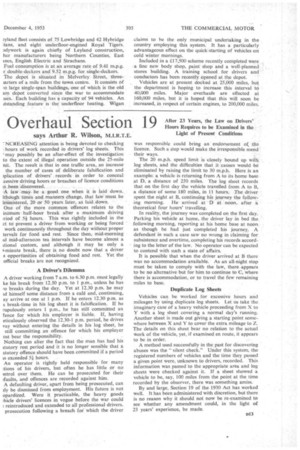Overhaul Section 19
Page 53

If you've noticed an error in this article please click here to report it so we can fix it.
says Arthur R. Wilson, M.I.R.T.E.
7 NCR-EASING attention is being devoted to checking ;hours of work recorded in drivers' log sheets. This may possibly be an after-effect of the investigation to the extent of illegal operation outside the 25-mile nit. The result is -that in one traffic area, an increase the number of cases of deliberate falsification and Mlication of drivers' .-recordsin order to conceal cessive-driving hours or breaches of licence conditions is• beenIdiscovered., .
-A law may be a good, one when it is laid down._ ithough times and manners change, that law must be [ministered, 20 or 50 years later, .as laid down. . One of the more common offences relates to the inieouriy half-hour break after a maximum driving :riod of 5i hours. This was rightly included in the et to` prevent a driver. from working or being forced work continuously throughout-the day without proper terVals for food and rest. Since then,mid-morningid mid-afternoon tea intervals have become almost a itional custom, and although it may be only a [-minute break, there is no doubt now that a driver s opportunities of obtaining food and rest. Yet the official breaks are not recognized.
A Driver's Dilemma A driver working from 7 a.m. to 6.30 p.m. must legally ke his break from 12.30 p.m. to 1 p.m., unless he has ro breaks during the day. Yet at 12.30 p.m. he may id himself some distance from a cafe and, continuing, ay arrive at one at 1 p.m. If he enters 12.30 p.m. as s break-time in his log sheet it is falsification. If he rupulousiy enters 1 p.m., he has still committed an fence for which -his employer is liable, If, having eticulously observed the 12.30-1 p.m. period, he drives vay without entering the details in his log sheet, he still committing an offence for which his employer ust bear the responsibility. Nothing can alter the fact that the man has had his autory rest period and it is no longer. sensible that a atutory offence should have been committed if a period is exceeded 5 hours.
An operator is rightly held responsible for many lions of his drivers, but often he has little or no introl over them. He can be prosecuted for their faults, andoffences are recorded against him. A defaulting driver, apart from being prosecuted, can tly be dismissed from employment. His future is not opardized. Were it practicable, the heavy goods hide drivers' licences in vogue before the war could ; reintroduced and extended to all professional drivers. prosecution following a breach for' which the driver
was responsible could bring an endorsement ot, the licence. Such a Step would Make the irresponsible mendtheir ways. The 20 m.p.h. speed limit is closely bound up with log sheets, and the difficulties that it 'causes would be eliminated by raising the limit to 30 m.p.h. Here is an example: a vehicle is returning from A to its home base at D, a distance of 250 miles. The log sheet recordsthat on the first day the vehicle travelled from A to B, a distance of some 180 miles, in 11 hours. The driver spent the night at 8, continuing his journey the following morning. He arrived at -D at. noon, after a theoretical four hours' travelling. In reality, the journey was completed on the first day. Parking his vehicle at home, the driver lay in bed the following morning, reporting at his home base at noon • as though he had just completed his journey. A defendant in such a case saw no wrong in claiming for. subsistence and overtime, completing his records according to the letter of the law. No operator can be expected to contend with such a state of affairs.
It is possible that when the driver arrived at B there was no accommodation available. As an all-night stop must be taken to comply with the law, there. appears to be no alternative but for him to continue to C, where there is accommodation, or to travel the few remaining miles to base.
Duplicate Log Sheets
Vehicles can be worked for excessive hours and mileages by using duplicate log sheets. Let us take the imaginary case of a heavy vehicle proceeding from X to Y with a log sheet covering a normal day's running. Another sheet is made out giving a starting point somewhere between X and Y to cover the extra mileage to Z. The details on this sheet bear no relation to the actual stork of the vehicle, yet, if examined en route, it appears to be in order.
A method used successfully in the past for discovering abuses was the "silent check." Under this system, the registered numbers of vehicles and the time they passed a given point were, unknown to drivers, recorded. This information was passed to the appropriate area and tog sheets were checked against it. If a sheet showed a vehicle to be, say, 100 miles from the point at the time recorded by the observer, there was something amiss.
By and large, Section 19 of the 1930 Act has worked well. It has been administered with discretion, but there is no reason why it should not now be re-examined to see whether any amendment could, in the light of 23 years' experience, be made.
































































































